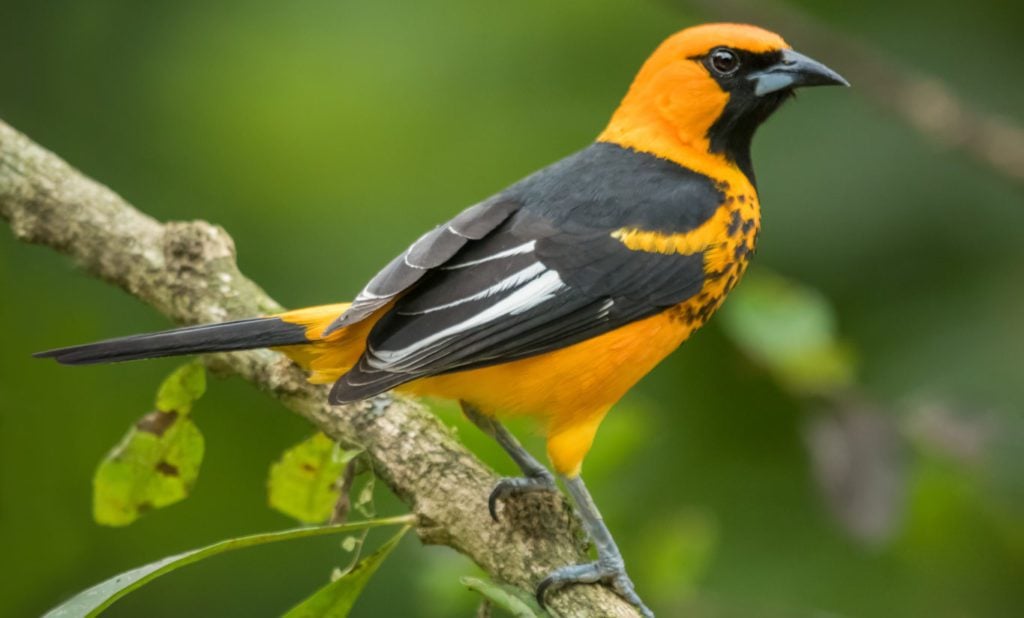The 3 Oriole Species in Florida! (w/ Range Maps)
What types of orioles can you find in Florida?

Few birds get me as excited as seeing Baltimore Orioles in my backyard each spring, either sipping grape jelly or feeding on orange halves. It’s no wonder these beautiful blackbirds (Yes, all orioles are part of the Icteridae family and considered blackbirds 🙂 ) draw so much attention and are a favorite amongst many people, both birders and non-birders alike.
Below are the 3 types of orioles that live in Florida!
Make sure to pay attention to the range maps below to see which orioles live near you! For each species, I have included a few photographs, along with their most common sounds, to help you identify any birds you are lucky enough to observe.
- *RELATED: Watch the LIVE bird feeder and animal cameras in MY backyard* (You may get lucky and see an oriole eating jelly on my cams RIGHT NOW!)
#1. Baltimore Oriole

Listen for the whistling songs of Baltimore Oriole’s year-round in Florida. Male birds, being a stunning combination of orange and black with white wing bars, are unmistakable. Females are beautiful in their own way, featuring duller colors than the males while lacking a black hood and back.
Baltimore Oriole Range Map

These birds spend most of their time at the tops of deciduous trees, fluttering around, building beautiful woven nests, and looking for food. They are most often found in open woodlands, riverbanks, and on the edges of swamps and forests. Even though they enjoy trees, they normally aren’t seen in deep, dark forests.
Baltimore Orioles LOVE eating ripe fruit and nectar!
These two sugary foods provide lots of energy, while insects give them the nutrition they need.
Baltimore Orioles are the most commonly seen oriole in Florida. And luckily, these birds are relatively easy to attract to your bird feeders, as long as you use the foods they enjoy eating.
- RELATED: 8 LIVE Bird Feeder Cams From Around the World! (INCLUDING MINE 🙂 )

Baltimore Orioles in MY Backyard!
Try using one of these strategies below:
- Ripe fruit, such as bananas, cherries, grapes, or various berries. Orioles are attracted to the color orange, so putting out orange slices works best in my backyard.
- Grape jelly, placed in a cup, is a treat that orioles find hard to resist. You may also see catbirds and woodpeckers sampling the jelly.
- Similar to hummingbirds, Baltimore Orioles love drinking nectar from flowers. You can take advantage of this fact by setting out oriole-friendly nectar feeders at your bird feeding station.
- I have also seen Baltimore Orioles eating suet and sunflower seeds in my backyard.
Press PLAY above to hear a Baltimore Oriole singing!
Baltimore Orioles are often heard before being seen since they live so high up in trees. Listen for males to make a flutelike whistling noise while defending their breeding territory. Females also sing, but it’s shorter and used to communicate with her mate.
Scientific Name: Icterus galbula
#2. Orchard Oriole

While most orioles species feature bright orange plumage, male Orchard Orioles are a darker orange and appear rust-colored. Females are greenish-yellow, with white wing bars on black wings.
Orchard Orioles are fairly common in Florida during summer and migration.

Orchard Oriole Range Map
But these shy birds are not often seen because they spend most of their time at the tops of trees. Preferred habitat includes the edges of rivers, swamps, lakeshores, open woodlands, farms, and scrublands. In winter, they migrate south to Mexico through South America.
While many oriole species regularly visit bird feeders, Orchard Orioles are much harder to attract to them. You are probably more likely to see these orioles in your backyard searching for insects in shrubby vegetation or eating mulberries from a tree. But if you’re lucky, you may see them at your feeders eating sunflower seeds or orange slices, drinking sugar water from a nectar feeder, or sipping a bit of grape jelly.
Press PLAY above to hear an Orchard Oriole singing!
An Orchard Oriole’s song is similar to an American Robin, except it’s more varied. Listen for a series of loud whistles that lasts 3-4 seconds, which is used to attract mates.
Scientific Name: Icterus spurius
#3. Spot-breasted Oriole

In North America, this oriole can only be found in Florida, but interestingly, it does not occur there naturally. Native to Central America, the Spot-breasted Oriole was introduced into the Miami area of southern Florida in the 1940s.
Since then, these birds have established themselves as part of the local ecosystem, but they are not incredibly numerous. They are most often seen nesting and living in suburban communities. Spot-breasted Orioles can’t survive cold weather, which is why they have not extended their range more northward.
Both males and females look similar with a black bib, orange head, and black breast spots. The only caveat is that juvenile birds look different and are tricky to identify because they look similar to female Baltimore Orioles.
If you’re in south Florida, listen for a series of rich, slow whistles that sound like “whee ch-wee-chu-u.”
Scientific Name: Icterus pectoralis
Do you need help attracting orioles?
Try reading this article that I wrote. It should help!
Which of these orioles have you seen before in Florida?
Leave a comment below!

